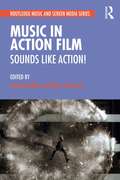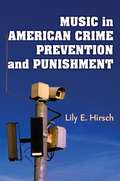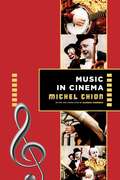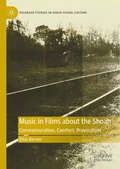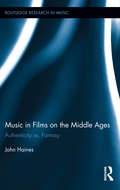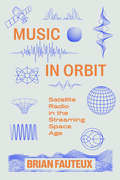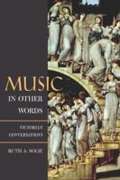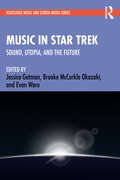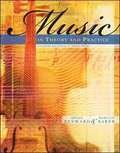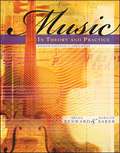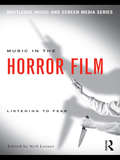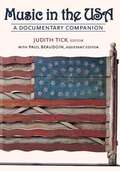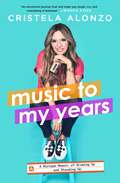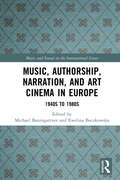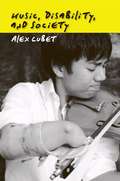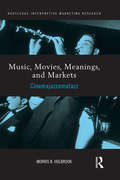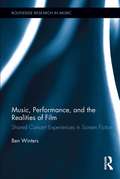- Table View
- List View
Music in Action Film: Sounds Like Action!
by James Buhler Mark DurrandMusic in Action Film is the first volume to address the central role of music and sound in action film—arguably the most dominant form of commercial cinema today. Bringing together 15 essays by established and emerging scholars, the book encompasses both Hollywood blockbusters and international films, from classic works such as The Seven Samurai to contemporary superhero franchises. The contributors consider action both as genre and as a mode of cinematic expression, in chapters on evolving musical conventions; politics, representation, and identity; musical affect and agency; the functional role of music and sound design in action film; and production technologies. Breaking new critical ground yet highly accessible, this book will be of interest to students and scholars of music and film studies.
Music in American Crime Prevention and Punishment
by Hirsch Lily E.Although the use of music for extramusical purposes has been a part of American culture for some time, the phenomenon remained largely unknown to the general public until revelations became widespread of startling military practices during the second Iraq War. In Music in American Crime Prevention and Punishment, Lily E. Hirsch explores the related terrain at the intersection of music and law, demonstrating the ways in which music has become a tool of law enforcement and justice through: police and community leaders’ use of classical music in crime deterrence and punishment; the use of rap lyrics as prosecutorial evidence; allegations of music as incitement to violence; and the role of music in U. S. prisons and in detention centers in Guantanamo, Iraq, and Afghanistan. In the course of her study, Hirsch asks several questions: How does the law treat music? When and why does music participate in the law? How does music influence the legal process? How does the legal process influence music? And how do these appropriations affect the Romantic ideals underlying our view of music?
Music in Cinema (Film and Culture Series)
by Michel ChionMichel Chion is renowned for his explorations of the significance of frequently overlooked elements of cinema, particularly the role of sound. In this inventive and inviting book, Chion considers how cinema has deployed music. He shows how music and film not only complement but also transform each other.The first section of the book examines film music in historical perspective, and the second section addresses the theoretical implications of the crossover between art forms. Chion discusses a vast variety of films across eras, genres, and continents, embracing all the different genres of music that filmmakers have used to tell their stories. Beginning with live accompaniment of silent films in early movie houses, the book analyzes Al Jolson’s performance in The Jazz Singer, the zither in The Third Man, Godard’s patchwork sound editing, the synthesizer welcoming the flying saucer in Close Encounters of the Third Kind, and the Kinshasa orchestra in Felicité, among many more. Chion considers both original scores and incorporation of preexisting works, including the use and reuse of particular composers across cinematic traditions, the introduction of popular music such as jazz and rock, and directors’ attraction to atonal and dissonant music as well as musique concrète, of which he is a composer.Wide-ranging and original, Music in Cinema offers a welcoming overview for students and general readers as well as refreshingly new and valuable perspectives for film scholars.
Music in Everyday Life
by Tia DenoraThe power of music to influence mood, create scenes, routines and occasions is widely recognised and this is reflected in a strand of social theory from Plato to Adorno that portrays music as an influence on character, social structure and action. There have, however, been few attempts to specify this power empirically and to provide theoretically grounded accounts of music's structuring properties in everyday experience. Music in Everyday Life uses a series of ethnographic studies - an aerobics class, karaoke evenings, music therapy sessions and the use of background music in the retail sector - as well as in-depth interviews to show how music is a constitutive feature of human agency. Drawing together concepts from psychology, sociology and socio-linguistics it develops a theory of music's active role in the construction of personal and social life and highlights the aesthetic dimension of social order and organisation in late modern societies.
Music in Films about the Shoah: Commemoration, Comfort, Provocation (Palgrave Studies in Audio-Visual Culture)
by Elias BernerThis book focuses on the aural and musical sphere of fictional audio-visual reconstructions of the Holocaust, a defining event in the history of the 20th century. Musicology has seen an increasing number of works on the function of film music and the construction of identity in media contexts in recent years. This project analyses the use of music in feature films about the Shoah. The analysis of 'the sound of Nazi violence', as well as the escape from and resistance against it, not only reveals a lot about the construction of the filmic characters' emotive states, but also tells us more about our own relationship to the past. The author understands the soundtrack of these films as an affective mediator of time, which connects filmic representations of the past with the present. Analysis focuses on the soundtracks of four films: Schindler's List, The Pianist, Taking Sides and Inglourious Basterds.
Music in Films on the Middle Ages: Authenticity vs. Fantasy (Routledge Research in Music #7)
by John HainesThis book explores the role of music in the some five hundred feature-length films on the Middle Ages produced between the late 1890s and the present day. Haines focuses on the tension in these films between the surviving evidence for medieval music and the idiomatic tradition of cinematic music. The latter is taken broadly as any musical sound occurring in a film, from the clang of a bell off-screen to a minstrel singing his song. Medieval film music must be considered in the broader historical context of pre-cinematic medievalisms and of medievalist cinema’s main development in the course of the twentieth century as an American appropriation of European culture. The book treats six pervasive moments that define the genre of medieval film: the church-tower bell, the trumpet fanfare or horn call, the music of banquets and courts, the singing minstrel, performances of Gregorian chant, and the music that accompanies horse-riding knights, with each chapter visiting representative films as case studies. These six signal musical moments, that create a fundamental visual-aural core central to making a film feel medieval to modern audiences, originate in medievalist works predating cinema by some three centuries.
Music in Orbit: Satellite Radio in the Streaming Space Age
by Brian FauteuxYears before the advent of music streaming, Sirius and XM established satellite radio services that attracted paying subscribers through their ever-expanding lineup of niche music channels and exclusive celebrity-hosted programming. Music in Orbit is the first book to explore how satellite radio bridges legacy broadcast music radio and streaming platforms, serving as both precursor and integral player in today's streaming media environment. Arguing for the ongoing significance of radio in the digital age and the pernicious effects of monopoly power on the vibrancy of contemporary music industries, Music in Orbit offers essential context for the serious problems now facing working musicians, music consumers, and music communities.
Music in Other Words: Victorian Conversations
by Ruth A. SolieJust as the preoccupations of any given cultural moment make their way into the language of music, the experience of music makes its way into other arenas of life. To unearth these overlapping meanings and vocabularies from the Victorian era, Ruth A. Solie examines sources as disparate as journalism, novels, etiquette manuals, religious tracts, and teenagers' diaries for the muffled, even subterranean, conversations that reveal so much about what music meant to the Victorians. Her essays, giving voice to "what goes without saying" on the subject--that cultural information so present and pervasive as to go unsaid--fill in some of the most intriguing blanks in our understanding of music's history. This much-anticipated collection, bringing together new and hard-to-find pieces by an acclaimed musicologist, mines the abundant casual texts of the period to show how Victorian-era people--English and others--experienced music and what they understood to be its power and its purposes. Solie's essays start from topics as varied as Beethoven criticism,Macmillan's Magazine,George Eliot'sDaniel Deronda,opera tropes in literature, and the Victorian myth of the girl at the piano. They evoke common themes--including the moral force that was attached to music in the public mind and the strongly gendered nature of musical practice and sensibility--and in turn suggest the complex links between the history of music and the history of ideas.
Music in Star Trek: Sound, Utopia, and the Future
by Jessica Getman Brooke McCorkle Okazaki Evan WareThe tensions between utopian dreams and dystopian anxieties permeate science fiction as a genre, and nowhere is this tension more evident than in Star Trek. This book breaks new ground by exploring music and sound within the Star Trek franchise across decades and media, offering the first sustained look at the role of music in shaping this influential series. The chapters in this edited collection consider how the aural, visual, and narrative components of Star Trek combine as it constructs and deconstructs the utopian and dystopian, shedding new light on the series’ political, cultural, and aesthetic impact. Considering how the music of Star Trek defines and interprets religion, ideology, artificial intelligence, and more, while also considering fan interactions with the show’s audio, this book will be of interest to students and scholars of music, media studies, science fiction, and popular culture.
Music in Theory and Practice, Volume 1 (8th edition)
by Bruce Benward Marilyn SakerThis best-selling text gives majors a solid foundation in the theory of music - generally and throughout history. It strengthens their musical intuition, builds technical skills, and helps them gain interpretive insights. The two-volume format ensures exhaustive coverage and maximum support for students and faculty alike. Volume I serves as a general introduction to music theory while volume II offers a survey of the theoretical underpinnings of musical styles and forms from Gregorian Chant through the present day.
Music in Theory and Practice, Volume 2 (8th edition)
by Bruce Benward Marilyn SakerThis best-selling text gives majors a solid foundation in the theory of music - generally and throughout history. It strengthens their musical intuition, builds technical skills, and helps them gain interpretive insights. The two-volume format ensures exhaustive coverage and maximum support for students and faculty alike. Volume I serves as a general introduction to music theory while volume II offers a survey of the theoretical underpinnings of musical styles and forms from Gregorian Chant through the present day.
Music in Twin Peaks: Listen to the Sounds
by Katherine M. ReedIn this edited volume, contributors explore an essential element of the influential television series Twin Peaks: the role of music and sound. From its debut in 1990 to its return to television in 2017, Twin Peaks has amassed a cult following, and inspired myriad scholarly studies. This collection considers how the music and sound design not only create the ambience of this ground-breaking series, but function in the narrative, encouraging multiple interpretations. With chapters that consider how music shapes the relationship of audiences and fans to the story, the importance of sound design, and the symbolism embedded in the score, this book provides a range of perspectives for scholars of music and film studies, while giving fans new insight into an iconic television show.
Music in Twin Peaks: Listen to the Sounds (Routledge Music and Screen Media Series)
by Katherine M. ReedIn this edited volume, contributors explore an essential element of the influential television series Twin Peaks: the role of music and sound. From its debut in 1990 to its return to television in 2017, Twin Peaks has amassed a cult following, and inspired myriad scholarly studies. This collection considers how the music and sound design not only create the ambience of this ground-breaking series, but function in the narrative, encouraging multiple interpretations. With chapters that consider how music shapes the relationship of audiences and fans to the story, the importance of sound design, and the symbolism embedded in the score, this book provides a range of perspectives for scholars of music and film studies, while giving fans new insight into an iconic television show.
Music in the Horror Film: Listening to Fear
by Neil LernerMusic in Horror Film is a collection of essays that examine the effects of music and its ability to provoke or intensify fear in this particular genre of film. Frightening images and ideas can be made even more intense when accompanied with frightening musical sounds, and music in horror film frequently makes its audience feel threatened and uncomfortable through its sudden stinger chords and other shock effects. The essays in this collection address the presence of music in horror films and their potency within them. With contributions from scholars across the disciplines of music and film studies, these essays delve into blockbusters like The Exorcist, The Shining, and The Sixth Sense together with lesser known but still important films like Carnival of Souls and The Last House on the Left. By leading us with the ear to hear these films in new ways, these essays allow us to see horror films with fresh eyes.
Music in the Shadows: Noir Musical Films
by Sheri Chinen BiesenSome musical films use film noir style and jazz to reveal the dark side of fame and the American Dream.Smoke. Shadows. Moody strains of jazz. Welcome to the world of "noir musical" films, where tormented antiheroes and hard-boiled musicians battle obsession and struggle with their music and ill-fated love triangles. Sultry divas dance and sing the blues in shrouded nightclubs. Romantic intrigue clashes with backstage careers. In her pioneering study, Music in the Shadows, film noir expert Sheri Chinen Biesen explores musical films that use film noir style and bluesy strains of jazz to inhabit a disturbing underworld and reveal the dark side of fame and the American Dream. While noir musical films like A Star Is Born include musical performances, their bleak tone and expressionistic aesthetic more closely resemble the visual style of film noir. Their narratives unfold behind a stark noir lens: distorted, erratic angles and imbalanced hand-held shots allow the audience to experience a tortured, disillusioned perspective.While many musicals glamorize the quest for the spotlight in Hollywood's star factory, brooding noir musical films such as Blues in the Night, Gilda, The Red Shoes, West Side Story, and Round Midnight stretch the boundaries of film noir and the musical as film genres collide. Deep shadows, dim lighting, and visual composition evoke moodiness, cynicism, pessimism, and subjective psychological points of view.As in her earlier study of film noir, Blackout: World War II and the Origins of Film Noir, Biesen draws on extensive primary research in studio archives to situate her examination within a historical, industrial, and cultural context.
Music in the Shadows: Noir Musical Films
by Sheri Chinen BiesenAn analysis of Hollywood films that blend elements of musicals and film noir, from the author of Blackout: World War II and the Origins of Film Noir.Welcome to the world of “noir musical” films, where tormented antiheroes and hard-boiled musicians battle obsession and struggle with their music and ill-fated love triangles. Sultry divas dance and sing the blues in shrouded nightclubs. Romantic intrigue clashes with backstage careers.In her pioneering study, Music in the Shadows, film noir expert Sheri Chinen Biesen explores musical films that use film noir style and jazz to inhabit a disturbing underworld and reveal the dark side of fame and the American Dream. While noir musical films like A Star Is Born (1954) include musical performances, their bleak tone and expressionistic aesthetic more closely resemble the visual style of film noir. Their narratives unfold behind a stark noir lens: distorted, erratic angles and imbalanced hand-held shots allow the audience to experience a tortured, disillusioned perspective.While many musicals glamorize the quest for the Hollywood spotlight, brooding noir musical films such as Blues in the Night, Gilda, The Red Shoes, West Side Story, and Round Midnight stretch the boundaries of film noir and the musical as film genres collide. Deep shadows, dim lighting, and visual composition evoke moodiness, cynicism, pessimism, and subjective psychological points of view.Biesen draws on extensive primary research in studio archives to situate her examination within a historical, industrial, and cultural context.“Biesen builds a fascinating and quite convincing case for a genre hybrid, the noir musical, that took root in the 1940s but has continued to evolve ever since.” —Thomas Schatz, The University of Texas at Austin
Music in the USA: A Documentary Companion
by Judith Tick Paul E. BeaudoinMusic in the USA: A Documentary Companion charts a path through American music and musical life using as guides the words of composers, performers, writers and the rest of us ordinary folks who sing, dance, and listen. The anthology of primary sources contains about 160 selections from 1540 to 2000. Sometimes the sources are classics in the literature around American music, for example, the Preface to the Bay Psalm Book, excerpts from Slave Songs of the United States, and Charles Ives extolling Emerson. But many other selections offer uncommon sources, including a satirical story about a Yankee music teacher; various columns from 19th-century German American newspapers; the memoirs of a 19th-century diva; Lottie Joplin remembering her husband Scott; a little-known reflection of Copland about Stravinsky; an interview with Muddy Waters from the Chicago Defender; a letter from Woody Guthrie on the "spunkfire" attitude of a folk song; a press release from the Country Music Association; and the Congressional testimony around "Napster. " "Sidebar" entries occasionally bring a topic or an idea into the present, acknowledging the extent to which revivals of many kinds of music play a role in American contemporary culture. This book focuses on the connections between theory and practice to enrich our understanding of the diversity of American musical experiences. Designed especially to accompany college courses which survey American music as a whole, the book is also relevant to courses in American history and American Studies.
Music to My Years: A Mixtape Memoir of Growing Up and Standing Up
by Cristela AlonzoIn this memoir full of humor and heart, comedian, writer, and producer Cristela Alonzo shares personal stories of growing up as a first-generation Mexican-American in Texas and following her dreams to pursue a career in comedy. When Cristela Alonzo and her family lived as squatters in an abandoned diner, they only had two luxuries: a television and a radio, which became her pop cultural touchstone and a guiding light. Cristela shares her experiences and struggles of being a first-generation American, her dreams of becoming a comedian, and how it feels to be a creator in a world that often minimizes people of color and women. Her stories range from the ridiculous—like the time she made her own tap shoes out of bottle caps or how the theme song of The Golden Girls landed her in the principal’s office—to the sobering moments, like how she turned to stand-up comedy to grieve the heartbreaking loss of her mother and how, years later, she’s committed to giving back to the community that helped make her. Each significant moment of the book relates to a song, and the resulting playlist is deeply moving, resonant, and unforgettable. Music to My Years will make you laugh, cry, and even inspire you to make a playlist of your own.
Music! Its Role and Importance in Our Lives
by George Degraffenreid Charles Fowler Timothy Gerber Vincent LawrenceMusic! Its Role and Importance In Our Lives is focused upon the use and value of music in people's lives. It encourages students to view music in a social context rather than as abstract information to be learned for its own sake. It presents music as a natural and essential ingredient of one's own life and of human life in all cultures. This book was written for all students, not just those who sing in the chorus or play in the band or orchestra.
Music, Authorship, Narration, and Art Cinema in Europe: 1940s to 1980s (Music and Sound on the International Screen)
by Michael Baumgartner Ewelina BoczkowskaMusic, Authorship, Narration, and Art Cinema in Europe: 1940s to 1980s investigates the function of music in European cinema after the Second World War up to the fall of the Berlin wall, a period when composers and directors embraced experimentation. Through analyses of music and sound in a wide range of iconic films from across Europe, the essays in this book provide a nuanced reconsideration of three core themes: auteur theory, art house film, and national cinema. Chapters written by an international array of contributors focus on case studies of music in the cinema of Carlos Saura, Jean-Pierre Melville, the Polish School, and Romanian directors, as well as collaborations between directors and composers, including Michelangelo Antonioni and Giovanni Fusco, Federico Fellini and Nino Rota, Leo Arnshtam and Dmitry Shostakovich, and Peter Greenaway and Michael Nyman. The contributors shift the emphasis from a director-centered view to the working relationship between director and composer, and from the visual component to the sonic aspects of these films, without ignoring the close correlation between soundtrack and visual elements. Enriching our understanding of the complex, intertwined nature of authorship in film, the role of film music, and sound, nation-state and art cinema, and European cinematic history, this volume offers a valuable addition to research across music and film studies.
Music, Collective Memory, Trauma and Nostalgia in European Cinema after the Second World War (Music and Sound on the International Screen)
by Michael Baumgartner Ewelina BoczkowskaIn the wake of World War II, the arts and culture of Europe became a site where the devastating events of the 20th century were remembered and understood. Exploring one of the most integral elements of the cinematic experience—music—the essays in this volume consider the numerous ways in which post-war European cinema dealt with memory, trauma and nostalgia, showing how the music of these films shaped the representation of the past. The contributors consider films from the United Kingdom, Poland, the Soviet Union, France, Italy, Germany, and the Netherlands, providing a diverse and well-rounded understanding of film music in the context of historical memory. Memory is often underrepresented within scholarly musical studies, with most of these applications found in the disciplines of ethnomusicology, popular music studies, music cognition, and psychology and music therapy. Likewise, trauma has mainly been studied in relation to music in only a few historical contexts, while nostalgia has attracted even less academic attention. In three parts, this volume addresses each area of study as it relates to the music of European cinema from 1945 to 1989, applying an interdisciplinary approach to investigate how films use music to negotiate the precarious relationships we maintain with the past. Music, Collective Memory, Trauma and Nostalgia in European Cinema after the Second World War offers compelling arguments as to what makes music such a powerful medium for memory, trauma and nostalgia.
Music, Disability, and Society
by Alex LubetMusical talent in Western culture is regarded as an extraordinary combination of technical proficiency and interpretative sensitivity. In Music, Disability, and Society, Alex Lubet challenges the rigid view of technical skill and writes about music in relation to disability studies. He addresses the ways in which people with disabilities are denied the opportunity to participate in music. Elaborating on the theory of "social confluence," Lubet provides a variety of encounters between disability and music to observe radical transformations of identity. Considering hand-injured and one-handed pianists; the impairments of jazz luminaries Django Reinhardt, Horace Parlan, and "Little" Jimmy Scott; and the "Blind Orchestra" of Cairo, he shows how the cultural world of classical music contrasts sharply with that of jazz and how musicality itself is regarded a disability in some religious contexts. Music, Disability, and Society also explains how language difference can become a disability for Asian students in American schools of music, limiting their education and careers. Lubet offers pungent criticism of the biases in music education and the music profession, going so far as to say that culture disables some performers by adhering to rigid notions of what a musician must look like, how music must be played, who may play it, and what (if any) is the legitimate place of music in society. In Music, Disability, and Society, he convincingly argues that where music is concerned, disability is a matter of culture, not physical impairment.
Music, Movies, Meanings, and Markets: Cinemajazzamatazz (Routledge Interpretive Marketing Research)
by Morris HolbrookMusic, Movies, Meanings, and Markets focuses on macromarketing-related aspects of film music in general and on the cinemusical role of ambi-diegetic jazz in particular. The book examines other work on music in motion pictures which has dealt primarily with the traditional distinction between nondiegetic film music (background music that comes from off-screen and is not audible to the film’s characters, to further the dramatic development of plot, character, or other themes) and diegetic music (source music produced on-screen and/or that is audible to the film’s characters, adding to the realism of the mise-en-scène without contributing much to other dramatic meanings). This book defines, describes, and illustrates another hitherto-neglected type of film music –ambi-diegetic film music, which appears on-screen but which contributes to the dramatic development of plot, character, and other themes. Consistent with an interest in macromarketing, such ambi-diegetic film music serves as a kind of product placement (suitable for commercialization via the cross-promotion of soundtrack albums, for example) and plays a role in product design. It also provides one type of symbolic consumer behavior that indicates choices made by film characters when playing-singing-listening-or-dancing in ways that reveal their personalities or convey other cinemusical meanings. Morris Holbrook argues that ambi-diegetic film music sheds light on various social issues –such as the age-old tension between art and entertainment as it applies to the contrast between creative integrity and commercialization. Music, Movies, Meanings, and Markets explores the ways in which ambi-diegetic jazz contributes to the development of dramatic meanings in various films, many of which address the art-versus-commerce theme as a central concern.
Music, Music for Everyone
by Vera B WilliamsA beautiful celebration of the power of music and of community—a companion book to the beloved Caldecott Honor picture book A Chair for My Mother."Rosa organizes her friends into the Oak Street Band in order to earn money her family needs because of her grandma's illness. Community, family and personal triumphs converge, making unforgettable music for everyone." —School Library Journal"Visual references connect readers to earlier books about Rosa's three-generation family, while the theme here underscores the interrelationship of Rosa to her foremothers, her girl friends, and their neighborhood. Images rich in vitality are placed within superbly composed, bordered watercolor paintings to convey the spirit of the story as well as details of their daily living." —BCCBVera B. Williams's beloved picture book favorites include:"More More More," Said the BabyAmber Was Brave, Essie Was SmartA Chair for AlwaysA Chair for My MotherCherries and Cherry PitsMusic, Music for EveryoneSomething Special for MeStringbean's Trip to the Shining SeaThree Days on a River in a Red Canoe
Music, Performance, and the Realities of Film: Shared Concert Experiences in Screen Fiction (Routledge Research in Music)
by Ben WintersThis book examines the relationship between narrative film and reality, as seen through the lens of on-screen classical concert performance. By investigating these scenes, wherein the performance of music is foregrounded in the narrative, Winters uncovers how concert performance reflexively articulates music's importance to the ontology of film. The book asserts that narrative film of a variety of aesthetic approaches and traditions is no mere copy of everyday reality, but constitutes its own filmic reality, and that the music heard in a film's underscore plays an important role in distinguishing film reality from the everyday. As a result, concert scenes are examined as sites for provocative interactions between these two realities, in which real-world musicians appear in fictional narratives, and an audience’s suspension of disbelief is problematised. In blurring the musical experiences of onscreen observers and participants, these concert scenes also allegorize music’s role in creating a shared subjectivity between film audience and character, and prompt Winters to propose a radically new vision of music’s role in narrative cinema wherein musical underscore becomes part of a shared audio-visual space that may be just as accessible to the characters as the music they encounter in scenes of concert performance.
